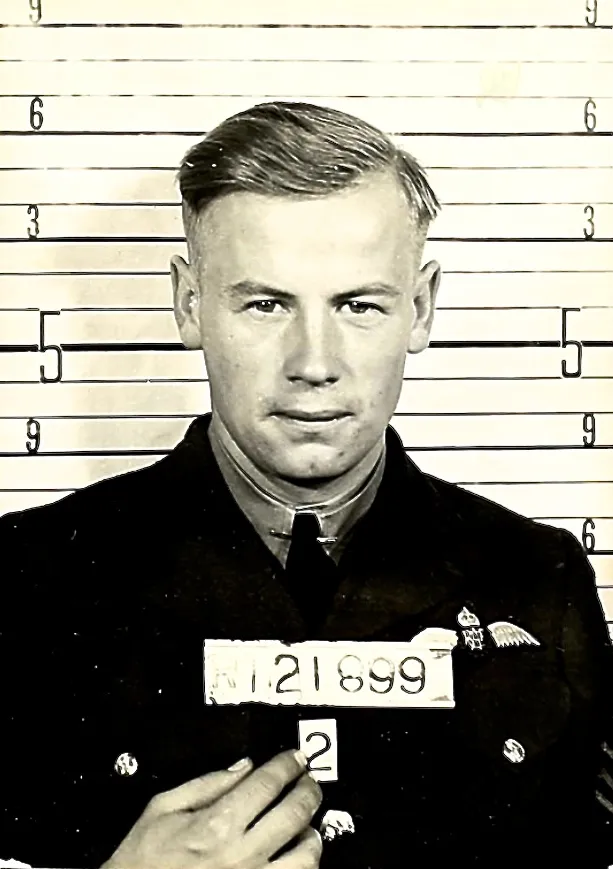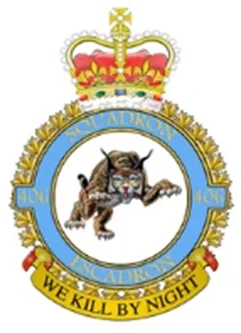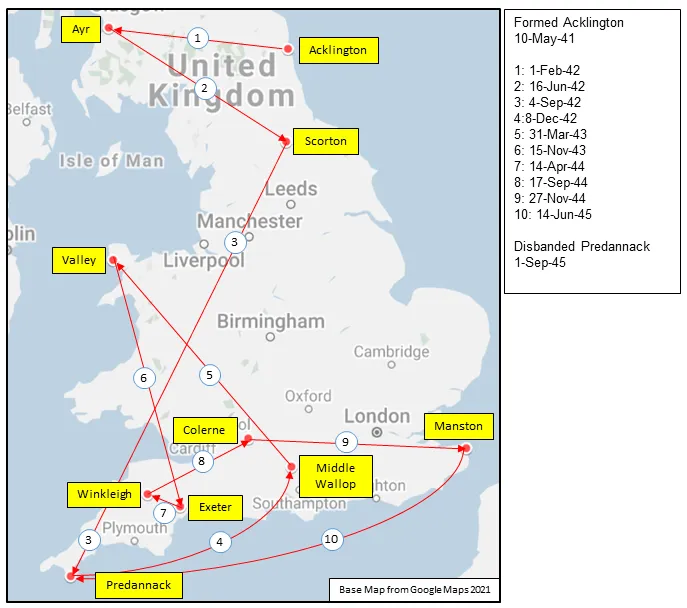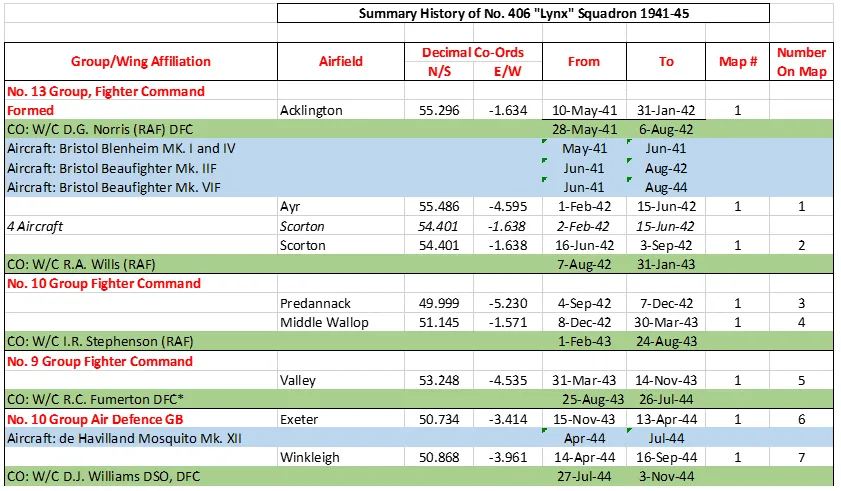Hereford, Winston Isaac (Flight Sergeant)
Killed in Action 1943-June-07


Birth Date: 1920
Born:
Parents: Son of Bert E. Hereford and Anna E. Hereford, of Nordegg, Alberta, Canada.
Spouse:
Home: Nordegg, Alberta
Enlistment:
Enlistment Date: unkown date
Service
RCAF
Unit
406 Sqn- Squadron
We Kill By Night
Base
Rank
Flight Sergeant
Position
Pilot
Service Numbers
R/121899
Home
Crew or Other Personnel
Beaufighter X8261
Beaufighter serial: X8261

Bristol Beaufighter, coded PN-B.
The Bristol Type 156 Beaufighter (often referred to simply as the "Beau") was a multi-role aircraft developed during the Second World War in the UK. It was originally conceived as a heavy fighter variant of the Bristol Beaufort bomber. Upon its entry to service, the Beaufighter proved to be well suited to the night fighter role, for which the RAF initially deployed the type during the height of the Battle of Britain, in part due to its large size allowing it to accommodate both heavy armaments and early airborne interception radar without major performance penalties.
As its wartime service continued, the Beaufighter was used in many different roles; receiving the nicknames Rockbeau for its use as a rocket-armed ground attack aircraft, and Torbeau in its role as a torpedo bomber against Axis shipping, in which it came to replace the Beaufort which had preceded it. In later operations, it served mainly as a maritime strike/ground attack aircraft, RAF Coastal Command having operated the largest number of Beaufighters amongst all other commands at one point.
The Beaufighter saw extensive service during the war with the RAF (59 squadrons), Fleet Air Arm (15 squadrons), RAAF (seven squadrons), RCAF (four squadrons), USAAF (four squadrons), RNZAF (two squadrons), SAAF (two squadrons) and the Free Polish Air Force (one squadron). In addition, variants of the Beaufighter were also manufactured in Australia by the Department of Aircraft Production (DAP), often called the DAP Beaufighter. n the fall of 1940, Luftwaffe bombers, unable to escape Allied fighters by day, started flying night missions, where they would encounter much less opposition. Immediately, the Allies prepared their response: the improvement of interception radars used in ground controls, the use of twin-engine Bristol Beaufighters as night-fighter aircraft, and the development of the Mk. IV airborne interception radar. Faster than a Junkers Ju 88, the Beaufighter displayed impressive firepower. Three RCAF squadrons were involved in night fighter operations, Nos. 406, 409 and 410, created in the spring and summer of 1941. Harold Skaarup web page with revisions
Unit Desciption
406 Sqn We Kill By Night ("Lynx")
History of the Squadron during World War II (Aircraft: Blenheim I & IV, Beaufighter IIF & VIF, Mosquito XII & XXX)

The Squadron was formed at Acklington, Northumberland, UK ![]() on May 10, 1941 as the RCAF's 5th squadron formed overseas, as a night-fighter unit. It flew Blenheim, Beaufighter and Mosquito aircraft in the night air defence of Great Britain role, before being re-designated as an Intruder squadron in November 1944. It was listed as the top scoring RAF/RCAF Intruder unit for the period November 27 1944 until the end of WWII. The squadron was disbanded at Predannack, Cornwall, UK
on May 10, 1941 as the RCAF's 5th squadron formed overseas, as a night-fighter unit. It flew Blenheim, Beaufighter and Mosquito aircraft in the night air defence of Great Britain role, before being re-designated as an Intruder squadron in November 1944. It was listed as the top scoring RAF/RCAF Intruder unit for the period November 27 1944 until the end of WWII. The squadron was disbanded at Predannack, Cornwall, UK ![]() on Sep 1, 1945.
on Sep 1, 1945.
Overall, the squadron claimed 64 enemy aircraft destroyed, 7 probables and 47 damaged. Also claimed were 88 locomotives and many other vehicles. Squadron operational losses were 11 aircraft, 20 aircrew killed or missing and 2 POWs. The squadron personnel were awarded 3 DSOs, 1 second Bar to DFC, 1 Bar to DFC, 14 DFCs, 2 DFMs and 4 Mentioned in Dispatches. Battle Honours were: Defence of Britain 1941-45, English Channel and North Sea 1944, Fortress Europe 1943-44, France and Germany 1944-45: Biscay Ports 1944, Normandy 1944, Rhine: Biscay 1944.Wikipedia, Kostenuk and Griffin
Maps for Movements of 406 Squadron 1941-45

406 Sqn History Summary 1941-45

406 Sqn History Summary 1941-45 Page 2

History of the Squadron Post-WWII (Aircraft: Harvard II, Mitchell III, Silver Star, Expeditor, Otter, Sea King, Tracker, Cyclone)
The unit was re-formed as a reserve unit, 406 Tactical Bomber Squadron (Auxiliary) on 1 April 1947 at RCAF Station Saskatoon ![]() . It flew B-25 Mitchell III light bombers, and also Harvard and T-33 Silver Star aircraft for army co-operation duties. It was re-designated 406 (Light Bomber) Squadron on 1 April 1949 and adopted the title City of Saskatoon in September 1952. In March 1958 under the name 406 Squadron, it was re-equipped with C-45 Expeditor and later CSR-123 Otter aircraft, and assigned to a light transport and emergency rescue role. The squadron was disbanded again on 1 April 1964 as a result of the reduction of the Auxiliary Force.
. It flew B-25 Mitchell III light bombers, and also Harvard and T-33 Silver Star aircraft for army co-operation duties. It was re-designated 406 (Light Bomber) Squadron on 1 April 1949 and adopted the title City of Saskatoon in September 1952. In March 1958 under the name 406 Squadron, it was re-equipped with C-45 Expeditor and later CSR-123 Otter aircraft, and assigned to a light transport and emergency rescue role. The squadron was disbanded again on 1 April 1964 as a result of the reduction of the Auxiliary Force.
The squadron was re-formed for a third time at CFB Shearwater, Nova Scotia ![]() on 12 July 1972 as the 406 Maritime Operational Training Squadron, operating the CH-124 Sea King helicopter and the CP-121 Tracker ASW aircraft. In mid-1981, the operational Tracker squadron, 880 Maritime Reconnaissance Squadron, was transferred CFB Summerside, which left 406 Squadron only responsible for Sea King training. At the present time, the squadron trains pilots, Air Combat Systems Officers (ACSOs), and Airborne Electronic Sensor Operators (AES Ops) on the CH-148 Cyclone aircraft and flight operations relevant to the Maritime Helicopter (MH) role. In addition, the Squadron’s Technical Training Flight conducts a wide range of avionics and aviation courses for Cyclone technicians, as well as specialty maintenance courses. On an annual basis, between 200 and 300 students graduate from 406 Squadron. The squadron’s partner squadrons 423 Squadron in Shearwater, N.S., and 443 Squadron in Patricia Bay, B.C., employ 406 Squadron Cyclone graduates as integral members of helicopter air detachments aboard Her Majesty’s Canadian ships.
on 12 July 1972 as the 406 Maritime Operational Training Squadron, operating the CH-124 Sea King helicopter and the CP-121 Tracker ASW aircraft. In mid-1981, the operational Tracker squadron, 880 Maritime Reconnaissance Squadron, was transferred CFB Summerside, which left 406 Squadron only responsible for Sea King training. At the present time, the squadron trains pilots, Air Combat Systems Officers (ACSOs), and Airborne Electronic Sensor Operators (AES Ops) on the CH-148 Cyclone aircraft and flight operations relevant to the Maritime Helicopter (MH) role. In addition, the Squadron’s Technical Training Flight conducts a wide range of avionics and aviation courses for Cyclone technicians, as well as specialty maintenance courses. On an annual basis, between 200 and 300 students graduate from 406 Squadron. The squadron’s partner squadrons 423 Squadron in Shearwater, N.S., and 443 Squadron in Patricia Bay, B.C., employ 406 Squadron Cyclone graduates as integral members of helicopter air detachments aboard Her Majesty’s Canadian ships.